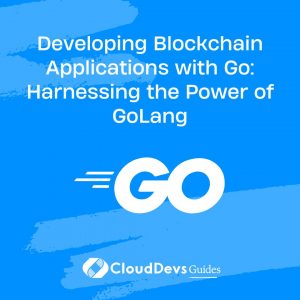Developing Blockchain Applications with Go: Harnessing the Power of GoLang
Blockchain technology has revolutionized various industries, offering decentralized, secure, and transparent solutions. GoLang (Go) has emerged as a popular programming language due to its simplicity, efficiency, and robustness. In this blog post, we will explore how to develop blockchain applications using Go, leveraging its powerful features to create secure and scalable decentralized applications.
Why GoLang for Blockchain Development:
GoLang is an ideal choice for blockchain development due to its unique characteristics. It offers a concise and readable syntax, making it easier to understand and maintain the codebase. Go’s concurrency model enables efficient parallel processing, which is crucial for handling the distributed nature of blockchain networks. Additionally, GoLang’s strong typing and built-in garbage collection ensure memory safety, reducing the chances of vulnerabilities in the application.
Setting Up the Development Environment:
To start developing blockchain applications with Go, you need to set up your development environment. Install GoLang and configure the necessary dependencies such as a code editor and version control system. Once set up, you can create a new project directory and initialize it as a Go module to manage dependencies effectively.
Understanding Blockchain Basics:
Before diving into the implementation, it’s essential to grasp the fundamental concepts of blockchain. Familiarize yourself with concepts such as blocks, transactions, hashing, and consensus algorithms like Proof of Work (PoW) or Proof of Stake (PoS). Having a strong understanding of these concepts will help you design and implement a robust blockchain application.
Creating a Blockchain Data Structure:
In this section, we will define the data structure for our blockchain application. The core component of a blockchain is a block, which contains transactional data and a reference to the previous block. We will create a Go struct to represent the block and define necessary functions for block validation and linking blocks to form a chain.
go
type Block struct {
Index int
Timestamp string
Data []byte
PrevHash []byte
Hash []byte
}
// Function to calculate the hash of a block
func (b *Block) CalculateHash() {
// Hash calculation logic
}
// Function to validate the integrity of a block
func (b *Block) ValidateBlock() bool {
// Block validation logic
}
Building a Consensus Algorithm:
Consensus algorithms ensure agreement among participants in a distributed system. Implementing a consensus algorithm is crucial for maintaining the integrity and consistency of the blockchain. You can choose from popular algorithms like Proof of Work (PoW) or Proof of Stake (PoS). Write the necessary functions and logic to validate and agree on the next block to be added to the chain.
go
// Function to validate a new block based on the consensus algorithm
func ValidateNewBlock(newBlock *Block, previousBlock *Block) bool {
// Consensus algorithm logic
}
// Function to reach consensus among participants for the next block
func ReachConsensus() {
// Consensus algorithm logic
}
Implementing Transactions and Smart Contracts:
Transactions represent the transfer of data or value between participants in a blockchain network. In this section, you will define the structure for transactions and write code to handle transaction validation, signing, and adding them to the blockchain. Additionally, you can explore implementing smart contracts using Go’s built-in features or external frameworks like Ethereum’s Solidity.
go
type Transaction struct {
Sender string
Receiver string
Amount float64
// Additional fields as per requirements
}
// Function to validate a transaction
func ValidateTransaction(tx *Transaction) bool {
// Transaction validation logic
}
// Function to add a validated transaction to the blockchain
func AddTransactionToBlockchain(tx *Transaction) {
// Add transaction logic
}
Securing the Blockchain:
Blockchain security is paramount to prevent unauthorized access and tampering. GoLang provides various cryptographic libraries and functions to implement security measures like hashing algorithms, digital signatures, and encryption. Ensure that you use these libraries to secure the transactions, block data, and communication within the blockchain network.
Deploying and Testing the Blockchain Application:
Once you have implemented the core functionalities of your blockchain application, it’s time to deploy and test it. You can set up a local blockchain network or use existing public or private blockchain networks for testing. Write test cases to validate the behavior of your blockchain application under different scenarios and ensure its stability and reliability.
Conclusion:
In this blog post, we have explored the power of GoLang in developing blockchain applications. Go’s simplicity, efficiency, and concurrency model make it an excellent choice for building decentralized and secure applications. By understanding blockchain fundamentals, creating the blockchain data structure, implementing consensus algorithms, and securing the application, you can harness the full potential of GoLang for blockchain development. Start exploring the possibilities and build your own blockchain applications with Go today.
In conclusion, GoLang’s robustness and efficiency, combined with the decentralized nature of blockchain, provide an excellent foundation for developing secure and scalable blockchain applications. By following the steps outlined in this blog, you can leverage the power of GoLang to harness the potential of blockchain technology and build innovative solutions for various industries. Get started with GoLang and unlock the endless possibilities of decentralized applications today.
Table of Contents







